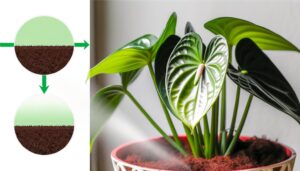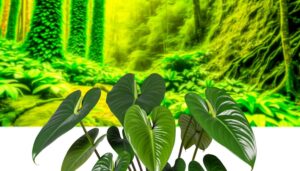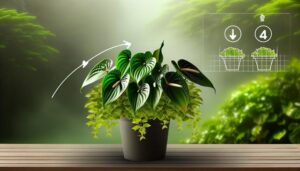Unique Features of Anthurium Magnificum Silver: Care Guide
Anthurium Magnificum Silver is notable for its large, heart-shaped, velvety leaves with distinctive silver veins. The adaxial surface exhibits a velvety texture owing to microscopic trichomes, while the abaxial surface contains a high stomatal density for efficient gas exchange.
Its silvery veins contrast beautifully against dark green foliage, enhancing both aesthetic appeal and photosynthetic efficiency. The robust petioles provide structural support to substantial leaf blades.
Ideal growing conditions include high humidity (60-80%), indirect light, and temperatures ranging from 18-25°C. This species demonstrates a unique interplay between aesthetics and biological functionality, making it a prized specimen in botanical collections.
Discover more intricate details about its care and advantages.
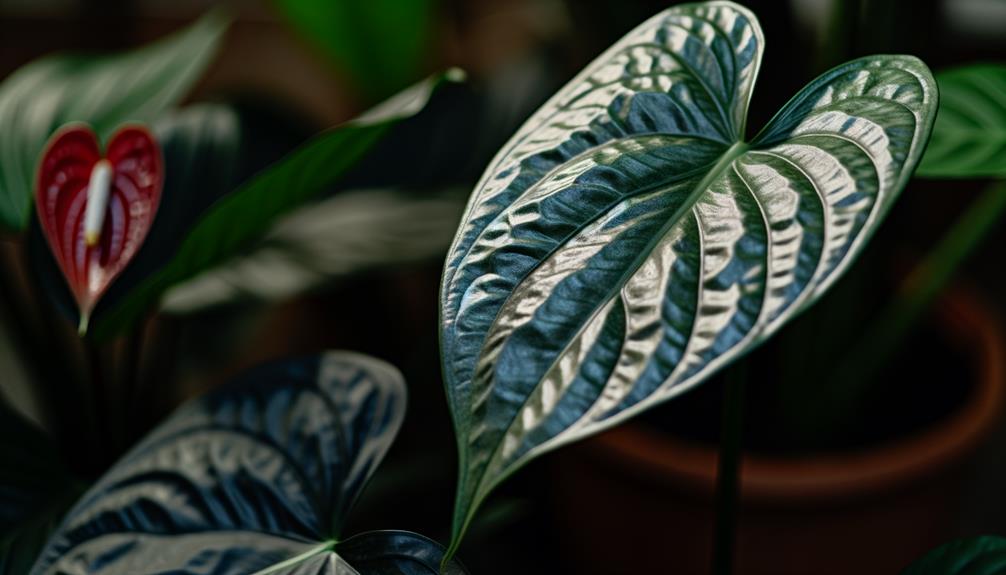
Key Takeaways
- Large, velvety heart-shaped leaves with prominent silver veins.
- Intricate leaf patterns with robust vascular systems for enhanced light absorption.
- Striking visual appeal with a reflective quality that boosts photosynthetic efficiency.
- Highly adaptable indoors with a preference for indirect, bright light and high humidity.
- Low maintenance with resilience, drought tolerance, and pest resistance.
Striking Foliage
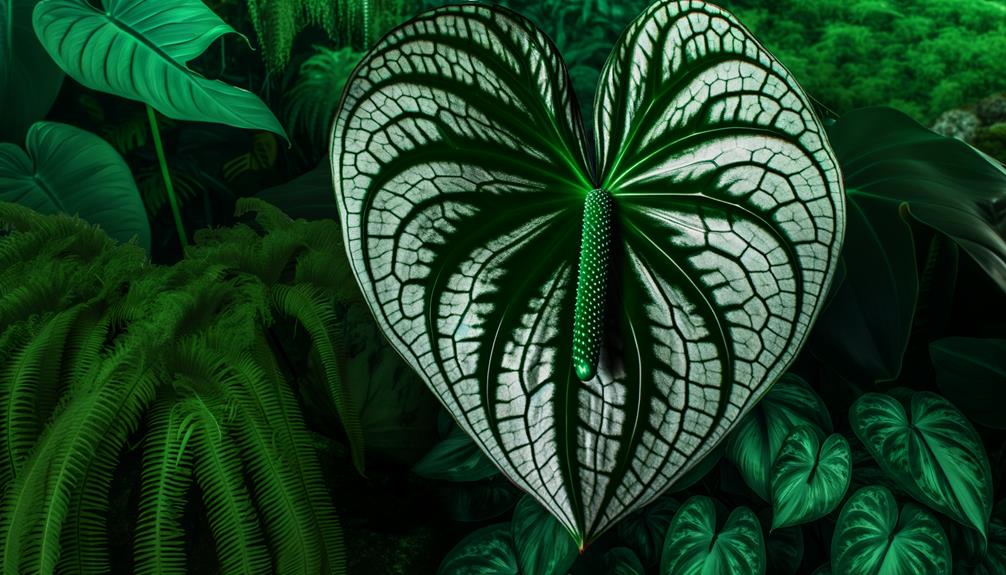
The Anthurium magnificum silver is distinguished by its striking foliage, characterized by large, velvety leaves with prominent silver veins that create a dramatic contrast against the deep green background.
These leaves, typically reaching up to 30-40 centimeters in length, possess a leathery texture and exhibit a heart-shaped morphology, a characteristic feature of the Araceae family.
The adaxial surface of the leaf is covered with microscopic trichomes, contributing to its velvety appearance.
Stomatal density and distribution on the abaxial surface play an essential role in gas exchange and transpiration regulation.
The robust petioles support the substantial leaf blades, facilitating ideal light capture for photosynthesis.
Collectively, these morphological traits underscore the plant’s evolutionary adaptations to its native tropical habitat.
Silvery Veins
The Anthurium magnificum silver is characterized by its prominent silvery veins, which provide a striking visual appeal and enhance its aesthetic value.
These silvery veins create distinctive leaf patterns that are both intricate and unique, setting this species apart from other Anthurium varieties.
The contrast between the dark green foliage and the shimmering silver veins underscores the plant’s ornamental significance and botanical allure.
Striking Visual Appeal
Characterized by its striking silvery veins, Anthurium magnificum Silver exhibits a unique foliar pattern that enhances its ornamental value.
These conspicuous veins, scientifically termed as venation, create a striking contrast against the deep green lamina. This juxtaposition not only highlights the leaf’s intricate vascular architecture but also augments its visual allure.
The reflective quality of the silvery veins enhances light absorption, contributing to the plant’s overall photosynthetic efficiency.
Moreover, the pronounced venation serves as an effective diagnostic feature for identifying Anthurium magnificum Silver among other Anthurium species.
This exceptional visual trait makes it a highly sought-after specimen for botanical enthusiasts and collectors, amplifying its desirability in both residential and commercial horticulture.
Distinctive Leaf Patterns
Possessing an intricate network of silvery veins, Anthurium magnificum Silver‘s foliage displays a distinctive pattern that sets it apart within the Anthurium genus.
The leaves exhibit a velvety texture with a deep green hue, accentuated by the prominent silvery venation, which follows the leaf’s natural contours.
This venation is not merely superficial; it is indicative of the plant’s robust vascular system, enhancing nutrient distribution and structural integrity.
The contrast between the dark green lamina and the shimmering veins creates a visually striking effect, enhancing its appeal among botanists and collectors.
Additionally, the silvery veins provide increased light absorption efficiency, contributing to the plant’s overall photosynthetic capacity, and thereby its vigorous growth and resilience in diverse environmental conditions.
Large, Velvety Leaves
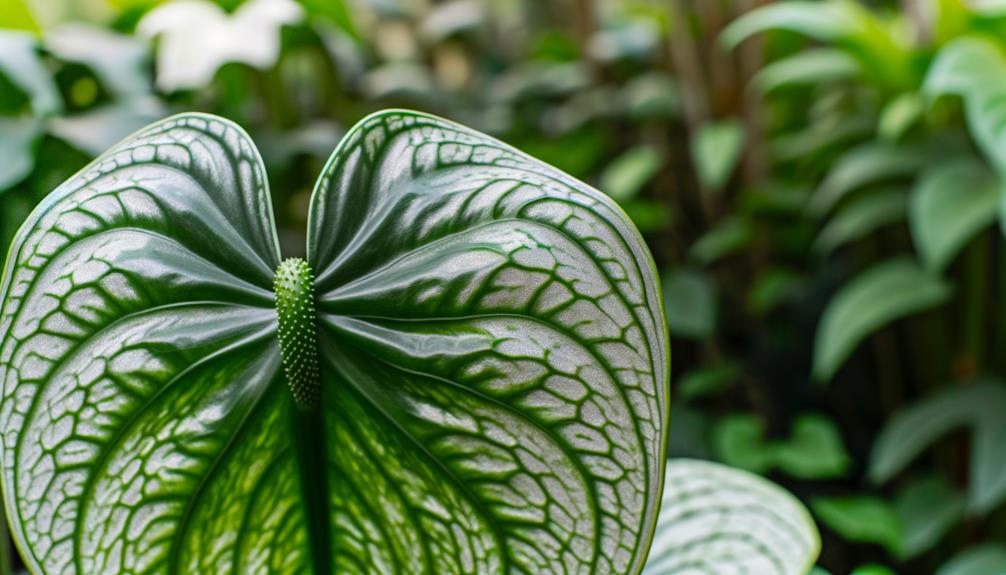
Renowned for its large, velvety leaves, Anthurium magnificum Silver boasts foliage that is both striking and tactilely distinct, contributing greatly to its allure among botany enthusiasts.
The leaves, classified under the Araceae family, are characterized by their substantial size, often reaching up to 30 centimeters in length.
The velvety texture is a result of a fine layer of trichomes, which not only enhances its visual appeal but also provides a unique tactile experience.
Key emotional highlights for enthusiasts include:
- Majestic Size: Each leaf’s impressive dimensions create a dramatic visual impact.
- Luxurious Texture: The velvety surface invites touch, adding sensory depth.
- Botanical Rarity: Its distinctive characteristics make it a prized specimen in collections.
Understanding these features can deepen appreciation for this exceptional plant.
Heart-Shaped Leaves
The heart-shaped leaves of Anthurium magnificum Silver exhibit a unique combination of texture and prominent veining, contributing to their distinctive appearance.
Variations in leaf size, often influenced by environmental factors, further add to the plant’s aesthetic appeal.
Additionally, the coloration and sheen of these leaves, ranging from deep green to silvery hues, create a striking visual contrast that enhances the plant’s ornamental value.
Leaf Texture and Veining
Anthurium magnificum silver exhibits heart-shaped leaves with a velvety texture and prominent, silver-white veining that provides a striking contrast against its deep green foliage.
This unique leaf structure serves several functions:
- Aesthetic Appeal: The silver-white veining creates an intricate pattern that enhances the plant’s visual allure.
- Photosynthetic Efficiency: The veining structure optimizes the distribution of nutrients and water, bolstering the plant’s photosynthetic capability.
- Structural Integrity: The pronounced veins not only add to the plant’s beauty but also fortify the leaf structure, ensuring durability.
The velvety texture, resulting from a dense layer of trichomes, contributes to water retention and protection against herbivory. These features collectively make the Anthurium magnificum silver a distinguished specimen in botanical collections.
Leaf Size Variations
In addition to its distinct leaf texture and veining, *Anthurium magnificum silver* exhibits significant variations in leaf size, with mature leaves often reaching impressive dimensions that further enhance its ornamental value.
The heart-shaped leaves can vary considerably, spanning from 20 to 40 centimeters in length and 15 to 30 centimeters in width. Such variation can be attributed to factors including genetic diversity, environmental conditions, and cultivation practices.
Larger leaves are generally more pronounced in their venation patterns, contributing to the plant’s visual appeal. The expansive leaf surface area also plays an essential role in photosynthetic efficiency, enabling the plant to thrive.
This characteristic makes *Anthurium magnificum silver* a highly sought-after specimen in botanical collections and interior landscapes.
Color and Sheen
Distinguished by a unique metallic sheen, the heart-shaped leaves of *Anthurium magnificum silver* exhibit a striking silver coloration that accentuates their intricate venation patterns.
This exceptional chromatic attribute is not merely aesthetic but also enhances the plant’s physiological functions.
The reflective quality of the leaves minimizes water loss through transpiration and maximizes light absorption for photosynthesis.
The enchanting appearance of Anthurium magnificum silver leaves elicits a sense of wonder through:
- Vibrant Contrast: The silver hue juxtaposes beautifully against the darker green foliage.
- Textural Depth: The metallic sheen highlights the leaf’s surface texture, creating a dynamic visual effect.
- Natural Elegance: The heart-shaped leaves exude an innate grace, enhancing any botanical collection.
These features contribute to the plant’s unique allure and ecological adaptability.
Robust Growth
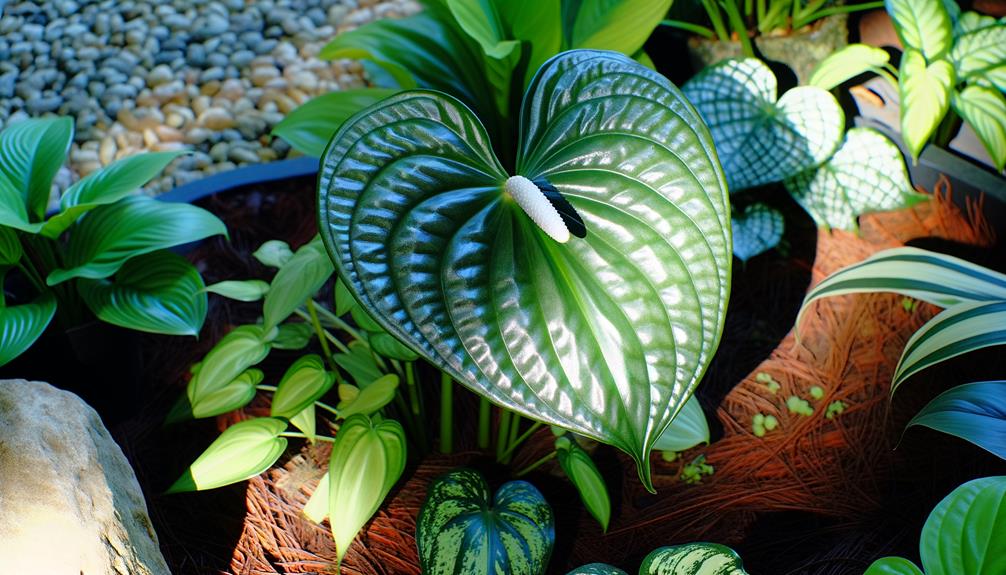
Renowned for its vigorous development, Anthurium magnificum Silver demonstrates robust growth patterns under ideal environmental conditions.
This species thrives in substrates rich in organic matter, coupled with consistent moisture levels and high humidity.
The following table elaborates on the key growth parameters:
| Parameter | Ideal Value | Importance |
|---|---|---|
| Temperature | 18-25°C | Optimum enzyme activity |
| Humidity | 70-80% | Prevents desiccation |
| Light Intensity | Indirect bright light | Photosynthetic efficiency |
| Soil Composition | Well-draining, organic-rich | Root health and nutrient uptake |
| Watering Frequency | Moderate, consistent | Prevents root rot and promotes growth |
Maintaining these conditions facilitates cellular proliferation and robust root development, ensuring that Anthurium magnificum Silver achieves its full vegetative potential.
Unique Coloring
Anthurium magnificum Silver exhibits a striking foliar pigmentation characterized by a silvery sheen overlaying deep green leaves, a unique feature that distinguishes it from other Anthurium species.
This remarkable coloration arises from specialized epidermal cells, which reflect light, creating the silvery appearance.
The juxtaposition of silver and green is not only visually enchanting but also serves several biological functions.
There are three notable aspects of this unique coloring:
- Aesthetic Appeal: The silver sheen provides an ornamental value that fascinates enthusiasts and collectors alike.
- Photosynthetic Efficiency: The reflective properties may enhance light capture, optimizing photosynthesis.
- Protective Function: The silvery overlay could potentially reduce leaf temperature and prevent photodamage.
This chromatic distinction elevates Anthurium magnificum Silver within botanical collections.
Indoor Adaptability
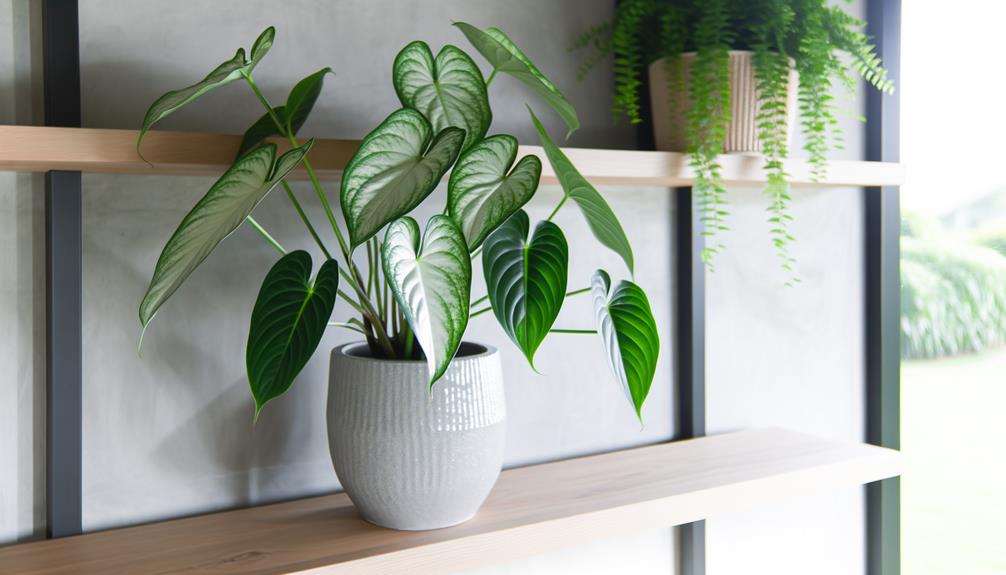
Exhibiting remarkable resilience and adaptability, Anthurium magnificum Silver thrives in indoor environments, making it a favored choice for interior horticulture.
This species demonstrates best growth when provided with indirect, bright light, mimicking its native understory habitat.
Maintaining a stable temperature range between 18-25°C (64-77°F) supports its physiological processes. Humidity levels around 60-80% are ideal, aligning with its tropical origins.
The plant’s root system benefits from well-aerated, loose substrate, promoting efficient nutrient absorption.
Regular but moderate watering, ensuring the soil remains moist but not saturated, prevents root rot.
The Anthurium magnificum Silver’s ability to acclimate to varying indoor conditions, coupled with its striking foliage, underscores its suitability as an ornamental indoor plant, appealing to both novice and experienced horticulturists.
Low Maintenance
In addition to its adaptability, the Anthurium magnificum Silver stands out as a low-maintenance plant, requiring minimal intervention to maintain its health and aesthetic appeal.
This species exhibits resilience and robustness, making it an excellent choice for those seeking both beauty and ease of care.
Key attributes contributing to its low-maintenance nature include:
- Drought Tolerance: The Anthurium magnificum Silver can withstand periods of low water availability, reducing the need for frequent watering.
- Pest Resistance: This plant shows a natural resistance to common pests, thereby diminishing the necessity for regular pesticide application.
- Slow Growth Rate: Its moderate growth rate minimizes the frequency of repotting and pruning, making it less labor-intensive.
These characteristics guarantee a seamless integration into any indoor environment.
Ideal Growing Conditions

Best growth of Anthurium magnificum Silver is achieved under conditions that mimic its native tropical rainforest habitat, including high humidity, indirect light, and well-draining soil.
Maintaining relative humidity levels between 60-80% is essential to replicate the moist environment these plants thrive in.
Light should be bright but diffused, avoiding direct sunlight which can scorch the leaves.
A substrate rich in organic matter, such as a combination of orchid bark, perlite, and peat moss, ensures sufficient drainage while retaining necessary moisture.
Optimal temperatures range between 18-25°C (64-77°F).
Regular misting and the use of a humidity tray can boost growth.
Fertilization with a balanced, water-soluble fertilizer during the growing season supports vigorous development.
Conclusion
Anthurium magnificum silver presents a botanical spectacle with its large, velvety, heart-shaped leaves adorned with striking silvery veins. This robust species boasts unique coloration that shimmers under indoor conditions, reflecting its adaptability and low maintenance requirements.
The plant’s lush foliage creates a visual tapestry of green and silver, evoking images of a verdant forest floor. Ideal growing conditions further enhance its vibrant growth, making this species a remarkable addition to any indoor botanical collection.


